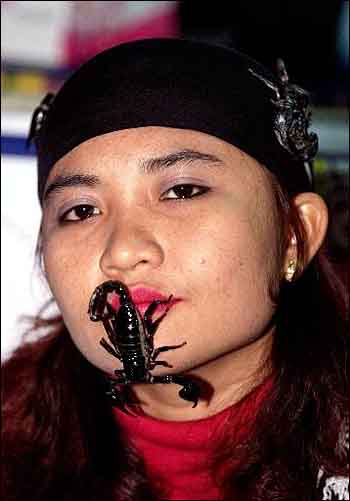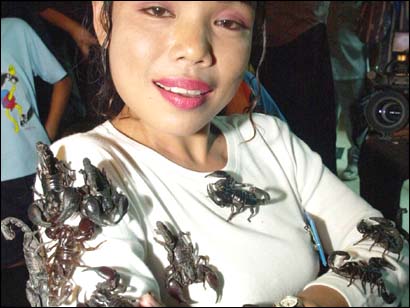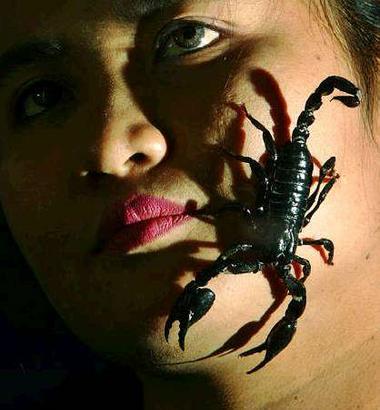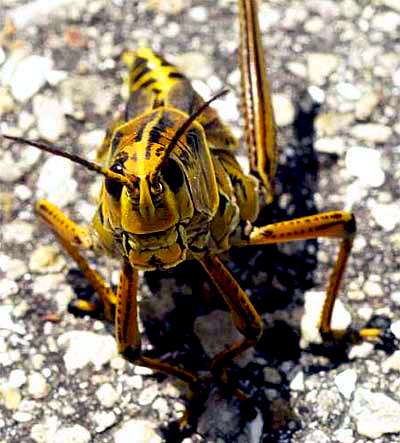Scorpions Are Major Cause of Death
Scorpions Are Major Cause of Death in Iran ProvinceThat is the Scorpion's endpoint: to live with intensity, to burn away all pretense, to put nothing behind walls of fear, to make the unconscious conscious. The aim of the Scorpion, in a word, is to live every minute as if it were the last. - Steven Forrest, Astrologer
Tehran - Scorpions are the fourth major cause of death in Iran's southern province of Khuzestan, a daily newspaper reported on Saturday. Quoting a report by state veterinary researchers, Qods said that after respiratory, infectious and digestive diseases, scorpions cause the greatest number of deaths in this humid, oil-rich province. The report did not give any figures on those killed, but said some 25,000 people were treated for scorpion stings in Khuzestan every year, adding that some 60 different varieties of the deadly insect could be found in Iran. "Population growth and urban development have brought the residents in closer contact with scorpions," the report added. Shortly after I read this, my husband was offered a six-month contract in Saudi Arabia. He ultimately turned it down because it didn't pay enough more than staying here to cover the risks as we perceived them. Having spent many years in the Southwest (in the Dallas, San Antonio, and Del Rio areas) where scorpions were abundant, and having been stung by a scorpion when I accidentally stepped near one in the dark, I assure you that they are a far from negligible risk. The scorpions we've encountered have been aggressive and apparently completely without fear. Of anything. Source: NandoTimes 8 August 1998 © Nando.net and Reuters News Service
The Scorpion Saga
Malena Hassan with a scorpion (AP) A Malaysian woman has survived her ordeal of living with thousands of scorpions in a locked glass room for 30 days. Malena Hassan has now been crowned Scorpion Queen after setting a Malaysian record and surviving seven stings at Kota Baru museum, Keltantan state. The 24-year-old began the challenge sharing a small cage in Kota Baru museum with 2,000 scorpions, but had another 700 added as "a challenge." She said: "This is my dream come true. I am very happy and proud as a Malaysian woman to have accomplished this very difficult record." Malena said she would use her newfound national fame to hold similar but smaller-scale shows across the Southeast Asian country, but her plan for Tuesday night was to get some proper sleep. Malena's trainer, Ali Khan Shamsudin, said his protégé, whom he handpicked to perform the feat from 36 women, seemed healthy despite having been stung seven times and running a high fever at one point. Ali, who lived with 5,000 scorpions for three weeks in 1997, said: "This has been a unique challenge and special feeling for both of us." Nicknamed "The Snake King", he said he had singled out Malena for her grit and perseverance. He said Malena trained under him using live snakes for about a year, and with scorpions for only 20 days. "Some people thought she couldn't do it, but she did it," he said. Under self-imposed rules, Malena only left the glass room once a day from July 1 for 15 minutes at a time. She slept, ate and performed Muslim prayers in the room, which was furnished with a bed and a table. Source: ananova.com Tuesday 31st July 2001
Kanchana Ketkeaw drapes herself with scorpions A Thai woman has draped herself with scorpions in an attempt to enter the Guinness Book of World Records. Kanchana Ketkeaw will aim to spend the next 32 days covered in 3,000 scorpions to break a world record. She began her stunt at Ripley's Believe It Or Not Museum in Pattaya, east of Bangkok. The scorpions are non-venomous and only eat insects. Of 1,500 species of scorpions worldwide, only about 20 to 25 are regarded as dangerous. Source: ananova.com Saturday 21 September 2002 photo credit Associated Press
Kuala Lumpur - Scorpions will be the bedfellows of a 24-year-old Malaysian woman for more than a month, as she tries to set a new world record for living with the venomous animals. Nur Malena Hassan moved into a glass box with 6,000 scorpions at a shopping mall in Kuantan, about 250 km (about 160 miles) east of Kuala Lumpur on Saturday, Malaysia's New Sunday Times reported. Nur Malena showed no sign of fear as she entered the box, the paper reported, and scorpions soon began crawling over her body as she was monitored by medical staff and officials from the Guinness World Book of Records. The current record is held by Kanchana Ketkaw of neighbouring Thailand, who lived with more than 3,000 scorpions for 31 days in 2002. Nur Malena, who may leave the glass box for only 15 minutes a day, was to have started her record attempt several days ago but struggled to find enough scorpions, the paper reported. Source: story.news.yahoo.com/news Sunday 22 August 2004 photo credit Reuters
Since Nur Malena Hassan was 24 in 2001 (attempt #1), it's hard for me to understand how she can still be 24 in 2004. (Caught in a time-warp, perhaps?) Her scorpions are said to be venomous while Kanchana Ketkeaw's scorpions are said to be non-venomous. Surely one venomous scorpion should count for two non-venomous ones? I also see where Ketkeaw had intended to stay for 32 days, but apparently came out after only 31. I wonder why. I suppose living with scorpions is better than some jobs these women might have. I can't help but wonder what they do with the scorpions when the feat has been accomplished. Do you suppose either woman wants one for a pet??
Nur Malena Hassan, 27, has broken a world record by enduring 32 days enclosed in a glass box with 6,069 scorpions, suffering seven stings in the process, her sponsor claimed. She will remain in the case, on display in a shopping mall in the eastern city of Kuantan, until Saturday, said Bohari Rahmat, whose biscuit company sponsored the stunt. Nur Malena surpassed the previous record held by Kanchana Ketkeaw from Thailand, who spent 31 days in a glass box with 3,400 scorpions, Bohari said. Bohari said he hadn't talked to Nur Malena since she reclaimed her record, which she first won in 2001 by living for 30 days with 2,700 scorpions. "We don't want her to lose focus, thinking that this is enough," Bohari said. "If we can reach 36 days, it will be more difficult for someone else to beat us next time." Source: local6.com
Us? Difficult for someone to beat us? Somehow I doubt that Bohari Rahmat spent time inside that cage, yet he claims part of the credit? Typical...
Venom "Lite" Alternative for Thrifty Scorpions
Based on an old RockFord Fosgate promotional image. Modelled in AutoCAD. by Randolph E Schmid Scorpions don't bother to waste venom killing a victim if they don't have to. Instead, they use a pre-venom that causes extreme pain, resorting to the deadlier version only when necessary, researchers discovered. A team led by entomologist Bruce D Hammock of the University of California, Davis, was researching the possibility of an anti-venom for scorpions when they discovered the stinging creatures produced two kinds of venom. When first confronted by a threat, the scorpion produced a clear liquid on its stinger, Hammock said. The more deadly venom, a thick liquid, "like a milkshake," was produced later, if the threat continued. It's a clever strategy, Hammock explained, because the deadly true venom uses lots of proteins and peptides that are costly for the scorpion to make. Instead, it tries first to get by with a faster acting and more painful toxin that doesn't kill, but is easier to make. The first scorpion weapon, what Hammock calls a pre-toxin, gets its kick largely from potassium salts that block receptors in animal cells, rapidly causing severe pain. "I was surprised," at the discovery of this pre-toxin, Hammock said. "We spent years looking at the very complex, highly toxic peptide toxin ...and the idea that the scorpion was using salt was a real surprise." It's of more than just biological interest that through evolution the scorpion has developed a way to generate pain and frighten predators and, if necessary, to follow this with a very highly toxic peptide toxin, Hammock said. Source: The Star Ledger Tuesday 21 January 2003 from the Associated Press in Washington; findings were reported in the online edition of Proceedings of the National Academy of Sciences; photo source: wincustomize.com author Dangeruss created 19 September 2002
Not All Bad...A peptide that naturally occurs in the venom of the giant yellow Israeli scorpion can pass through the bloodstream into the brain and can bind to glioma cells. Researchers at Cedars-Sinai Medical Center in California have created a synthetic version of this peptide, called TM-601, and are using it to deliver radioactive iodine into difficult-to-treat brain tumour cells left behind after surgery has removed the bulk of the tumour. Gliomas can be a particularly aggressive form of brain tumours, with only 8% of patients surviving two years and 3% surviving 5 years from the time of diagnosis. The median length of survival for all the patients in the study was 27 weeks, however, 2 patients had no evidence of tumour and were still alive 33 and 35 months after surgery.
Yellow Jackets Swarm, Kill Manby Josh Zimmer and Tamara Lush Keystone - Working around his home off Lake Glass gave 83-year-old Albert Wellner a sense of independence. Just to be safe, his wife of 52 years would check on him frequently. Late Monday morning, Wellner was clearing woods near his dirt driveway when he disturbed a large nest of yellow jackets nestled amid pine needles. He was swarmed. About 30 minutes later his wife, Eleanor, found his body near the riding mower, about 150 yards from their house, said their son, Tom Wellner. Wellner was stung "hundreds" of times, Hillsborough County, Florida sheriff's deputies say. An autopsy will be conducted. Wellner probably was dead long before emergency personnel arrived, Tom Wellner said. "His pleasure was getting out on his tractors and tooling around the house. He would work an hour or two at a time. He was a good man; I don't really know how else to put it." After the attack, authorities immediately called Jonathan Simkins, an entomologist who owns Insect IQ, a Tampa pest control company. Simkins arrived at the house about 20 minutes after Wellner was found. What he saw was chilling. "They were still swarming in a tornado-like fashion around the lawnmower," said Simkins, who estimated that there might have been 10,000 wasps in the underground nest. Yellow jackets make their nests out of wood fibres and saliva. Underground nests are often camouflaged by leaves, dirt and other natural matter. Pine needles covered the ground at the Wellner residence. Simkins thinks the noise and vibration of the lawnmower provoked the attack. "The nest was agitated," he said. "There were probably 2,000 on the outside of the nest, all over the palmetto fronds, just waiting to attack. It was unbelievable." It took Simkins and his employees, using insecticides and other materials, about 15 minutes to remove the nest and kill the yellow jackets. They wore veils, leather gloves, protective flannel suits and respirators to prevent being stung. Simkins and his company also worked on another yellow jacket attack that proved fatal. In September 1998, 2-year-old Harrison Johnson died after being stung hundreds of times by a swarm of the insects in the back yard of a friend's Tampa home. His parents said their son did not show overt signs of needing medical attention until 7 hours after the attack. An autopsy determined Harrison's brain had swollen from an undetermined amount of venom caused by 432 stings. The couple ultimately were cleared of wrongdoing. Most people who are stung by a yellow jacket have mild reactions - redness, itching and pain. University of Florida researchers say that it takes about 1,500 stings to kill an adult man. Wasp venom is toxic. Some sting victims die from a allergic reaction to the venom. As a comparison, in 2000, about 100 people died in the United States from bee stings. Getting rid of yellow jackets is not easy. Eradicating a nest is not as simple as squirting the insects with Raid, Simkins said. "You don't want to try to handle it yourself." People who think they have a nest on their property should call a professional, advises the University of Florida Entomology Department. The Wellners bought the property in northwest Hillsborough County in the late 1940s, Tom Wellner said. Because the Wellner's had moved around a lot as kids, they had wanted to give their own 3 children a more stable upbringing. Tom said his parents thought the homestead, called Leeward, was perfect. Albert Wellner was a systems analyst who installed one of the St Petersburg Times' first computer systems. Wellner had had only one year of college. "Basically he was self-taught," Tom Wellner said. "He was a very good problem solver and easy to work with." After leaving the Times in the late 1960s, Albert Wellner took a job at Lykes doing similar work. He retired from Lykes in 1984, a year after having his pituitary gland removed during a brain tumour operation. Besides being a dedicated family man, the soft-spoken Wellner was active in the Keystone Presbyterian Church. His mother will likely stay on the family's 10-acre property, Tom Wellner said. "They sure loved being in the country," he said. "I don't believe I can stand to part with it." Times researcher John Martin contributed to this story Source: St Petersburg Times 16 April 2002
Former Zoo Director in Indiana Dies After Suffering 1,000 Insect StingsFort Wayne, Indiana - A retired zoo director died after he was stung about 1,000 times by European yellow jackets when he fell onto their nest from a ladder while cleaning windows at his home. Earl Wells, 75, had been in a coma at Lutheran Hospital since the 12 September attack near Huntertown, about 10 miles north of Fort Wayne. He died Tuesday at the hospital. Wells was the director of the Fort Wayne Children's Zoo from its opening in 1965 until his retirement in 1994 and had served as a consultant in the design of other zoos around the country. European yellow jackets swarmed Wells when the stepladder he was standing on to wash windows collapsed onto their underground nest, the zoo said in a statement. He was unconscious when paramedics arrived. He suffered cardiac arrest in the attack and remained in a coma after being resuscitated, his family said. Source: ap.tbo.com The Associated Press 22 September 2004
We often had trouble with yellowjackets when we lived in Huntersville, North Carolina. Our house was sited in a grove of trees; leaves and pine needles covered much of the ground. Our gardener told us how to solve our problem: he said we should note the hole from which the yellowjackets flew - then go out after dark andinvert a clear glass bowl over that hole. He said the yellowjackets would fly out the next morning and fill the bowl. They couldn't get out, but they would crawl around all day trying to. That night, they would return underground. The next morning, they would fly out and fill the bowl again. They would do this day after day until they starved. He said if we merely plugged their hole, they would dig another - but if they could see outside, they wouldn't dig - they would just repeatedly try to get through the glass. We did that - and it worked. However, we didn't have thousands swarming. I would certainly call a professional if I ever encountered more than just a few. I've been stung many times in my life - especially on picnics as a child: yellowjackets love watermelon - and their stings hurt! See also:
Six-Foot Wasp Nest Removed from AtticPest controllers were called in to remove a giant 6-foot wasp nest from a family's attic in Germany. The family from Ravensberg said they had been plagued by wasps for weeks before they decided to contact the pest controllers. As the men entered the loft they discovered the six-foot-two-inch tall nest. The nest was removed from the attic and has been conserved. It is now set to be used for research purposes at the University of Rostock. Source: ananova.com Wednesday 22 October 2003
Spiders have moved to their own page.
Lubbers LandHow to Stop Giant Grasshoppers? "Hit 'em with 2-by-4," Expert Says
This king-sized grasshopper was found on County Road 48 in Lake County by Ramsey Campbell Eustis - Monstrous grasshoppers - too nasty-tempered and toxic to be eaten by natural predators and too big to be bothered by conventional pesticides - are on the rampage in Central Florida this summer. Alice McKinstry Davis, curator of the Eustis Historical Museum and Preservation Society, first saw the 4-inch creatures chowing down on a flower-garden smorgasbord outside the museum in downtown Eustis a few weeks ago. "We didn't know what to think," Davis said. "I'd never seen anything like them. They were devouring all our broadleaf plants." Davis ran for the bug spray. The king-sized grasshoppers just sneered. Alarmed, she called experts for help. "About all you can do is hit 'em with a 2-by-4," said Pris Peterson, master gardener at the Lake County Agricultural Centre. So Davis went out and rounded up some enthusiastic high-school volunteers willing to stomp on the critters. Between the teens and a direct application of an unusually potent insecticide, museum workers beat back the infestation. Davis had made the acquaintance of an Eastern lubber, which is to grasshoppers what King Kong was to apes. Yellow with red and black markings, it's the only one of the 70 species of grasshoppers that live in Florida that defies natural predators and insecticides. It's a nasty pest. Too fat to fly, lubbers can jump high and long. When disturbed, they spread their wings and hiss. Try to touch one, and it's likely to eject a foul-smelling, irritating foam intended to keep you away. It's highly effective. Agricultural officials and bug specialists from the University of Florida say no back yard in Central Florida is immune to a lubber infestation this year. Usually the population of Eastern lubbers is held back by lack of food or water, parasites and insect diseases. But the combination of a dry winter with a return to normal rainfall this summer may be responsible for a bumper crop in Central Florida, said John Capinera, a professor and chairman of UF's Department of Entomology. "Lubbers seem to like a wet environment," Capinera said. Capinera said he has been getting a rising number of inquiries about the bad boys of the insect world. But even though grasshoppers are the most abundant insect above ground, little is known about them. Scientists have learned that most grasshoppers are important in returning nutrients stored in plants back into the soil and as a food source for birds, reptiles, skunks, foxes and mice. Nothing finds lubbers tasty, however. Biologists think they are poison to birds, said Capinera, author of Grasshoppers of Florida, a field guide published last year. Lubbers favor shrubs, herbs, broadleaf plants and grasses - in other words, almost every plant on the farm or in the garden. If their numbers get out of control, they can cause significant crop damage. So far, however, they've just been startling homeowners unaccustomed to seeing grasshoppers that look as if they'd have a starring role in a horror flick. After all, they have five eyes, viselike jaws and ever-moving mouth parts. The best way to control the lubbers is to hope that something gets them when they're young - they're not so toxic then, and birds sometimes eat them. "But when they get older, they are too big and crunchy to be appetising," said Linda Landrum, an urban horticulturist with the Volusia County Cooperative Extension Service. Need to get them out of your back yard? You might try offering some to a local school - they're commonly used for dissection in biology courses because of their size. Other than that, you could try Landrum's favourite disposal method: grab the squirmy hoppers and drown them in a bucket of soapy water. Be advised, however, that catching and holding them down can be stinky, tricky and often gross. The lubbers tend to resist the procedure. Ramsey Campbell is a Sentinel staff writer; he can be reached at rcampbell@orlandosentinel.com or call 001 (352) 742-5923. Source: Orlando Sentinel 20 August 2002; photo credit Tom Benitez See also:
The last article on the page above is about the most deadly creature in the world. (I'll bet you'll never guess what that is...)
Insect trivia: The caterpillar has more than 2,000 muscles. There are more than 100,000 different species of butterfly. (That must mean there are more than 100,000 different types of caterpillars. That's a lot of muscle!)
For more on animals, including reptiles, crustaceans, arachnids, insects, fish, birds, pets, livestock, rodents, bears, primates, whales and Wellington's waterfront, click
"Up" below to take you to the Table of Contents for this Animals section. |
 Animals
Animals Animation
Animation Art of Playing Cards
Art of Playing Cards Drugs
Drugs Education
Education Environment
Environment Flying
Flying History
History Humour
Humour Immigration
Immigration Info/Tech
Info/Tech Intellectual/Entertaining
Intellectual/Entertaining Lifestyles
Lifestyles Men
Men Money/Politics/Law
Money/Politics/Law New Jersey
New Jersey Odds and Oddities
Odds and Oddities Older & Under
Older & Under Photography
Photography Prisons
Prisons Relationships
Relationships Science
Science Social/Cultural
Social/Cultural Terrorism
Terrorism Wellington
Wellington Working
Working Zero Return Investment
Zero Return Investment





